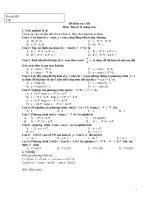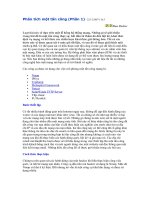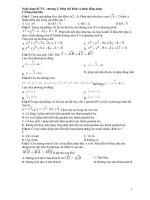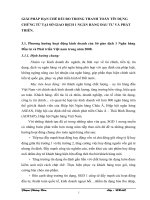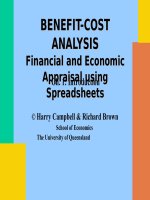macroeconomic mcgrowhill macroeconomic mcgrowhill macro ch 1 19e use this one
Bạn đang xem bản rút gọn của tài liệu. Xem và tải ngay bản đầy đủ của tài liệu tại đây (288.53 KB, 30 trang )
01
Limits, Alternatives, and
Choices
McGraw-Hill/Irwin
Copyright © 2012 by The McGraw-Hill Companies, Inc. All rights reserved.
Introduction
•
LO1
Economics defined:
•
Economic wants exceed
productive capacity.
•
A social science concerned
with making optimal choices
under conditions of scarcity.
1-2
The Economic Perspective
•
•
Thinking like an economist
Key features:
•
•
•
LO1
Scarcity and choice
Purposeful behavior
Marginal analysis
1-3
Scarcity and Choice
•
•
•
Resources are scarce
Choices must be made
Opportunity cost
•
LO1
There’s no free lunch
1-4
Purposeful Behavior
•
•
•
•
LO1
Rational self-interest
Individuals and utility
Firms and profit
Desired outcomes
1-5
Marginal Analysis
LO1
•
•
•
Marginal benefit
•
Comparison between marginal
benefit and marginal cost
Marginal cost
Marginal means change or
“extra”
1-6
Theories, Principles, and Models
•
The scientific method:
Observe
Formulate a hypothesis
Test the hypothesis
Accept, reject, or modify the hypothesis
Continue to test the hypothesis, if necessary
•
Economic principles
•
•
•
LO2
Generalizations
Other-things-equal assumption
Graphical expression
1-7
•
Microeconomics and
Macroeconomics
Microeconomics
•
•
Macroeconomics
•
LO3
Decision making by individual
units
Aggregate
1-8
Positive and Normative Economics
•
Positive economics
•
•
Normative economics
•
LO3
Deals with economic facts
A subjective perspective of
the economy
1-9
Individual’s Economizing Problem
•
•
•
Limited income
Unlimited wants
A budget line
•
•
•
•
LO4
Attainable and unattainable options
Tradeoffs and opportunity costs
Make the best choice possible
Change in income
1-10
Individual’s Economizing Problem
$120 Budget
12
DVDs Books
$20
$10
10
Income = $120
Quantity of DVDs
60
52
44
36
28
110
012
Pdvd = $20
8
Unattainable
6
Income = $120
= 12
Pb = $10
4
2
0
=6
Attainable
2
4
6
8
10
12
Quantity of Paperback Books
LO4
14
1-11
Global Perspective
LO4
1-12
Almost half the world — over three billion people
— live on less than $2.50 a day.
Society’s Economizing Problem
•
Scarce resources (Factors of
Production)
•
•
•
•
LO4
Land
Labor
Capital
Entrepreneurial Ability
1-14
Society’s Economizing Problem
•
Entrepreneurial ability
•
•
•
•
LO4
Takes initiative
Makes decisions
Innovates
Takes risk
1-15
The Market System
Five Fundamental Questions
Chapter Objectives
Economic Perspect
ive
Theories Principl
es and Models
Macro and Microec
onomics
Individual’s Econo
mizing Problem
Society’s Economiz
ing Problem
Production Possibil
ities Model
Unemployment, Grow
th, and the Future
Last Word
• Who Will Get the Output?
• How Will the System
Accommodate Change?
• How Will the System
Promote Progress?
–Technological Advance
–Creative Destruction
–Capital Accumulation
Key Terms
End Show
1-16
Copyright 2008 The McGraw-Hill Companies
The Market System
The “Invisible Hand”
Chapter Objectives
Economic Perspect
ive
Theories Principl
es and Models
Macro and Microec
onomics
Individual’s Econo
mizing Problem
Society’s Economiz
ing Problem
Production Possibil
ities Model
Unemployment, Grow
th, and the Future
Last Word
• 1776 Wealth of Nations by
Adam Smith
–Efficiency
–Incentives
–Freedom
Key Terms
End Show
1-17
Copyright 2008 The McGraw-Hill Companies
The Market System
Demise of Command Systems
Chapter Objectives
Economic Perspect
ive
Theories Principl
es and Models
Macro and Microec
onomics
Individual’s Econo
mizing Problem
Society’s Economiz
ing Problem
Production Possibil
ities Model
Unemployment, Grow
th, and the Future
Last Word
USSR
East Germany
Yugoslavia
• Two Insurmountable
Problems
–The Coordination
Problem
–The Incentive Problem
Key Terms
End Show
1-18
Copyright 2008 The McGraw-Hill Companies
Economic Efficiency
• Allocative
Chapter Objectives
Economic Perspect
ive
Theories Principl
es and Models
Macro and Microec
onomics
Individual’s Econo
mizing Problem
Society’s Economiz
ing Problem
Production Possibil
ities Model
Unemployment, Grow
th, and the Future
Last Word
Efficiency – Producing
what society wants
Marginal Benefit = Marginal Cost
•Productive Efficiency – Producing at
lowest cost
Lowest Average Total Cost
Key Terms
End Show
1-19
Copyright 2008 The McGraw-Hill Companies
Production Possibilities Model
•
•
Illustrates production choices
Assumptions:
•
•
•
•
LO5
Full employment
Fixed resources
Fixed technology
Two goods
1-20
Production Possibilities Table
Production Alternatives
Type of Product
Pizzas
A
B
C
D
E
0
1
2
3
4
10
9
7
4
0
(in hundred thousands)
Industrial Robots
(in thousands)
Plot the Points to Create the Graph…
LO5
1-21
Industrial Robots
Production Possibilities Curve
14
13
12
11
10
9
8
7
6
5
4
3
2
1
The law of
increasing
opportunity
costs makes
the PPC
concave.
A
B
Unattainable
C
D
U
Attainable
E
0
1
2
3
4
5
6
7
8 9
Pizzas
LO5
1-22
Marginal Benefit & Marginal Cost
Optimal Allocation
MC
15
c
MB = MC
e
10
5
0
LO5
a
b
d
MB
1
2
Quantity of Pizza
3
1-23
A Growing Economy
•
Economic Growth
•
•
•
LO6
More resources
Improved resource quality
Technological advances
1-24
A Growing Economy
Production Alternatives
Type of Product
Pizzas
A'
B'
C'
D'
E'
0
2
4
6
8
14
12
9
5
0
(in hundred thousands)
Industrial Robots
(in thousands)
LO6
1-25

